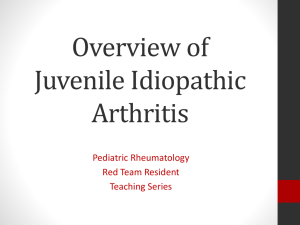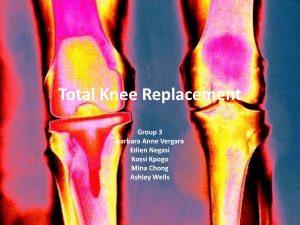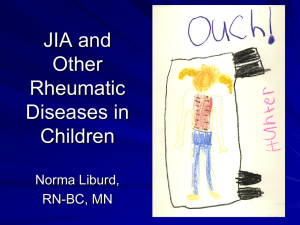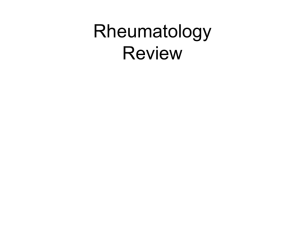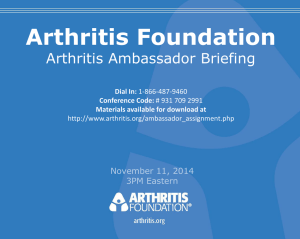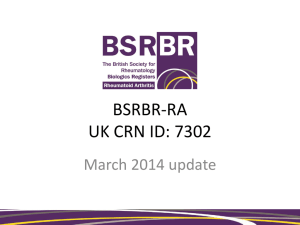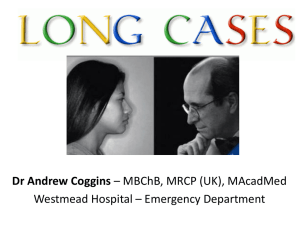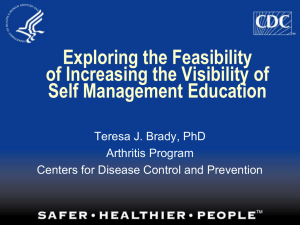Arthritis in Children
advertisement
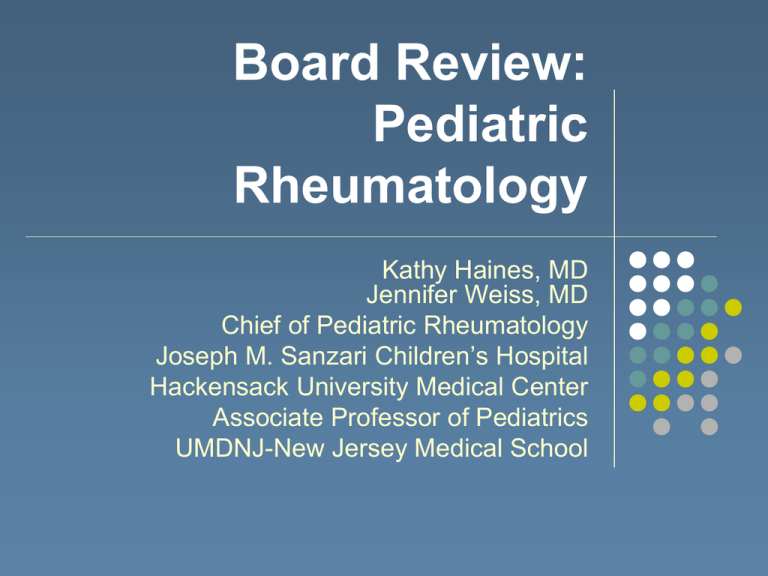
Board Review: Pediatric Rheumatology Kathy Haines, MD Jennifer Weiss, MD Chief of Pediatric Rheumatology Joseph M. Sanzari Children’s Hospital Hackensack University Medical Center Associate Professor of Pediatrics UMDNJ-New Jersey Medical School Arthritis More than 100 causes of arthritis in children Arthritis is common in rheumatic diseases But not all rheumatic diseases are associated with arthritis Acute Causes of Arthritis Traumatic Hemarthrosis Infectious Bacterial (septic arthritis, osteomyelitis, Lyme) Viral (esp rubella, parvo) Post-Infectious Reactive arthritis Toxic/transient synovitis Allergy Serum sickness Acute Inflammatory and Rheumatic Conditions HSP Kawasaki disease Rheumatic fever Most Common Causes of Chronic Arthritis in Children Juvenile Idiopathic Arthritis What we used to call “JRA” PLUS Juvenile Spondyloarthritis Juvenile Psoriatic Arthritis Other chronic rheumatic syndromes SLE Dermatomyositis Vasculitis Other causes of joint pain: Mimics of arthritis Mechanical abnormalities Patellofemoral Syndrome Hypermobility Syndromes Malignancies Endocrine abnormalities Inherited bony dysplasias Chronic pain syndromes Psychogenic causes Acute Rheumatic Syndromes Reactive arthritis Transient/toxic synovitis Henoch Schonlein Purpura Kawasaki Disease Acute Rheumatic Fever Reactive Arthritis (aka Reiter Syndrome) Arthritis and other extra-articular features following infections Classical triggers: Enteric (Salmonella, Shigella, Yersinia) Non-gonoccoal urethritis Other infections commonly cause reactive arthritis Varicella Parvovirus Group A Streptococcus (rheumatic fever and post-strep reactive arthritis) Many other nonspecific infections Extra-articular features: Conjunctivitis or uveitis Urethritis Rash (keratoderma blenorrhagicum) Not common in children Transient synovitis Acute hip synovitis in toddlers-early school age Often follows onset of URI Usually unilateral leg (hip) pain May have low grade fever Labs usually normal PE: Pain and limitation of motion of affected hip Self-limited: resolves within a few days to weeks Henoch Schonlein Purpura Common acute vasculitis of childhood Manifestations: Purpura Usually limited to lower extremities and buttocks Arthritis Nephritis Abdominal pain Usually self-limited (resolves after a few weeks) Often post-infectious (especially Strep) HSP HSP continued Purpuric rash on the LE is almost pathognomonic (in the absence of infection or coagulopathy) Biopsy: Leukocytoclastic vasculitis (seen in many other types of vasculitis) IgA deposits on IF (diagnostic for HSP) Nephritis: IgA nephropathy Usually manifests as hematuria which resolves Need to check urinalysis frequently (weekly) for a month and then monthly Some develop chronic renal disease HSP Treatment Symptomatic NSAIDs (joints) Steroids (reserved for significant GI involvement) Kawasaki Disease Most common vasculitis in young children Usually 6 years or younger Criteria (5 of 6 must be present for definite dx) 1. 2. 3. 4. 5. 6. High grade fever for more than 5 days Polymorphous rash (MP, scarlatiniform, morbilliform), often starts in the groin and diaper area Non exudative conjunctivitis Cervical lymphadenopathy >1.5 cm (usually unilateral) Mucositis (strawberry tongue, red lips and mouth, vertical cracking of lips) Extremity changes (red palms and soles, edema of hands and feet) KD conjunctivitis Polymorphous rash of KD Typical mucositis of KD Unilateral lymphadenopathy Acute Extremity Changes of KD Late extremity manifestations of KD Kawasaki Disease: Labs Labs reflect highly inflammatory state Elevated WBC, ESR, CRP Thrombocytosis comes later (1 to 2 wks after onset) Elevated LFTs (transaminases) common Sterile pyuria Aseptic meningitis No specific diagnostic test Kawasaki disease treatment Treatment Complications: IVIG (2gm/KG): best outcome if prior to 10 days of fever Low dose aspirin Other (for refractory cases): Pulse steroids Anti-TNF therapy Coronary artery aneurysms Myocarditis Myocardial infarction Atypical KD patients that do not fulfill criteria is not uncommon Fever, rash, conjunctivitis most common features Acute Rheumatic Fever Post-Streptococcal rheumatic syndrome Fever (usually low grade) and migratory polyarthritis 1-2 weeks following Strep infection (which can be subclinical) Carditis is common but not always present Mitral insufficiency most common Acute phase reactants (ESR and CRP) always elevated ARF Jones Criteria 2 Major criteria, or 1 Major and 2 minor criteria Major Migratory polyarthritis Carditis (valvulitis, especially mitral) Erythema marginatum Subcutaneous nodules Chorea Minor Fever Elevated ESR Arthralgias (doesn’t count if has polyarthritis as major) Prolonged PR interval Required: Evidence of recent Strep infection Uncommon Manifestations of ARF: Nodules and erythema marginatum Treatment of Acute Rheumatic Fever Aspirin or NSAIDs The arthritis will “melt away” Must be taken consistently until ESR normalizes Steroids reserved for severe carditis Penicillin prophylaxis (until adulthood?) PO Monthly IM bicillin A 6 year old boy has a 24 hr history of fever, malaise, and bruising. He appears ill and his temperature is 103. He has widespread petechiae and palpable purpura on the buttocks and lower extremities. The hgb is 10.5, WBC 22.5, and platelets are 25,000. The most likely diagnosis is: 30% 1. 2. 3. 4. 5. Idiopathic thrombocytopenic purpura HSP Leukemia Meningococcemia Rocky Mountain spotted fever 23% 23% 13% 10% 1 2 3 4 5 An 8 year old girl has a painful left knee. Two days ago her right ankle was painful and swollen, but today it seems fine. She has a fever to 101, and her resting heart rate is 120. Her knee is swollen and painful, but her ankle is completely normal. She has a Grade 3/6 systolic murmur. The most likely diagnosis is: 30% 30% 1. 2. 3. 4. 5. Dermatomyositis Systemic JIA Acute rheumatic fever Septic arthritis Systemic lupus erythematosus 23% 10% 7% 1 2 3 4 5 A 5 year old boy has been limping for 3 days. He had an URI earlier in the week and there is no hx of trauma. His temp is 99.9, and he is limping. There is pain with flexion and internal rotation of his right hip. The WBC is 4.5 and ESR is 20. The most likely diagnosis is: 30% 27% 1. 2. 3. 4. 5. Legg Perthes disease Slipped capitol femoral epiphysis Oligoarticular JIA Septic arthritis Transient synovitis 23% 13% 7% 1 2 3 4 5 Chronic Arthritis in Children Chronic Arthritis in Children (JRA and JIA) Pauciarticular JRA / Oligoarticular JIA Polyarticular JRA / Polyarticular JIA RF positive RF negative Systemic JRA / Systemic JIA Spondyloarthropathies / Enthesitis related JIA Psoriatic arthritis / Psoriatic JIA JRA/JIA Definition Must have had arthritis in at least one joint for > 6 weeks Must be less than 16 years old at onset of symptoms Must exclude all other conditions No tests are diagnostic Pauciarticular JRA Oligoarticular JIA Definition Usually little girls (average age: 2 yrs) Insidious onset of a swollen joint, most often the knee Labs usually normal except: Four or less joints ESR may be mildly elevated ANA often positive High risk of iritis/uveitis Uveitis in JIA Bone deformities, contractures & atrophy Polyarticular JRA Polyarticular JIA Definition: 5 or more joints involved No systemic sx RF serologic status is important in classification RF negative poly JIA (young girls: mean age 4) RF positive poly JIA (older pre- to teen aged girls >10 years) RF Negative Polyarticular JIA >5 joints, but usually has symmetrical arthritis in many joints, including small joints RF negative ANA + in 50% or more Elevated ESR, CRP, Ig’s Usually younger girls than RF positive Moderate risk for uveitis RF Positive Polyarticular JIA Positive rheumatoid factor test Identical to adult Rheumatoid Arthritis Pre-teen/teen onset most frequent Similar joint pattern to RF negative polyarthritis Elevated ESR, CRP Hallmark: rheumatoid nodules Systemic JRA or JIA Fevers High (>39) Quotidian pattern is common Rash Non-fixed pink eruption Worsens with fever spike Koebner phenomenon Arthritis (any number of joints can be affected) Other features: Generalized lymphadenopathy Hepato- or splenomegaly Serositis (Pleuritis or pericarditis) Quotidian Fever Pattern Systemic JIA Laboratory features High WBC (poly predominant) Anemia common Thrombocytosis (often 5-800,000) Very high ESR and CRP Extremely high ferritin levels (500-10,000+) Negative serologies Other complications Tamponade Macrophage activation syndrome (can be fatal) Pulmonary hypertension Uveitis is not seen Juvenile Spondylarthropathies Enthesitis related JIA Arthritis and enthesitis (usually calcaneal) More common in pre-teens and teens Boys > girls Other features HLA B-27 commonly positive Acute anterior uveitis Sacroiliitis Inflammatory spine pain and limitation of flexion Positive family history: anterior uveitis, spondylarthropathies, especially ankylosing spondylitis, Reiter syndrome and inflammatory bowel disease Spondylarthropathy / Enthesitis related JIA Features Juvenile Psoriatic Arthritis Psoriatic JIA Arthritis and psoriasis OR Arthritis and a positive family history of psoriasis plus dactylitis nail pitting or onycholysis Psoriatic arthritis features Psoriatic arthritis Can mimic any of the following: Oligoarticular JIA Polyarticular JIA Enthesitis related JIA and ankylosing spondylitis Dactylitis (isolated swollen digits) is the most specific type of arthritis associated with arthritis Dactylitis in psoriatic arthritis JIA Treatment in a nutshell Oligoarticular forms of JIA NSAIDs Intra-articular steroids Polyarticular forms of JIA NSAIDs Methotrexate Prednisone is not usually needed Anti-TNF biologics Systemic JIA NSAIDs Steroids for severe systemic symptoms (especially pericarditis) Methotrexate for arthritis Anti-IL1 and IL6 biologics A 6 yr old boy has a 4 week hx of fevers to 40 deg C once a day accompanied by a fleeting rash. Physical examination reveals generalized lymphadenopathy. Of the following, the most common other manifestation of this patient’s illness would be: 30% 1. 2. 3. 4. 5. Marked leukocytosis Positive ANA Positive RF Joint pain Uveitis 23% 20% 17% 10% 1 2 3 4 5 A 2 year old girl presents with a 2 month history of intermittent limping. She cries when she first gets up in the morning and won’t walk, but later on in the day she is much better. She has had no fever. On exam, she is happy and playful until you examine her right knee, which is swollen and warm and has decreased flexion. She is unable to straighten it completely. Her labs are normal but her ANA is positive. Which of the following is most 33% likely to develop in this child: 1. 2. 3. 4. 5. Psoriasis Lupus Uveitis Rheumatoid nodules Muscle weakness 27% 17% 13% 10% 1 2 3 4 5 Major Rheumatic Conditions SLE Dermatomyositis Scleroderma Vasculitis Childhood Systemic Lupus Erythematosus 10% of pediatric rheumatology patients It is a systemic disease that usually affects more than one organ Variable presentation Acute fulminant onset with life-threatening complications Chronic insidious onset (can be difficult to diagnose) Lupus is a systemic disease Rash (Malar rash classic, but many other skin manifestations) Arthritis Cytopenia Leukopenia and thrombocytopenia common Coombs’ positive hemolytic anemia Nephritis (proteinuria alone or with hematuria) Can present with nephrotic syndrome or renal insufficiency CNS manifestations Seizures Psychosis Other less common (transverse myelitis, coma, stroke) Pulmonary and/or cardiac involvement (especially pleuropericarditis) Laboratory testing for SLE Basic labs are important: CBC (may see cytopenias) ESR usually elevated in active lupus Renal and hepatic function (chemscreen) Urinalysis: proteinuria and hematuria Serologies: ANA (almost always positive, but not specific and can be falsely positive) Anti-dsDNA (much more specific for lupus, and can be used to follow disease activity) Complement levels are low in active SLE C3 and C4 Total complement Other Antibody Tests in SLE Anti-ENA Anti-SSA (Ro) and SSB (La) Anti-Sm or Smith (highly specific for SLE) Anti-RNP (associated with mixed connective tissue disease) Associated with Sjogrens as well as lupus Positive in mothers of babies who develop neonatal lupus Anti-phospholipid antibodies Anti-cardiolipin, anti-phosphatidyl serine, lupus anticoagulant and beta-2 glycoprotein I Associated with thromboembolic disease (pulmonary emboli, deep vein thrombosis, frequent miscarriages, arterial thrombosis) Treatment of Lupus Prednisone and pulse methylprednisolone For acute treatment of severe organ involvement (kidneys, CNS, pericarditis) Hydroxycholoquine (Plaquenil) Arthritis Rash General treatment of lupus Methotrexate Arthritis Cyclophosphamide, azathioprine or mycophenolate Significant renal and other organ system involvement Anti-B cell therapies (Rituximab) Neonatal Lupus Babies born to mothers with lupus or positive anti-SSA/SSB antibodies: Immune cytopenia Rash Congenital heart block can cause hydrops and fetal death Congenital heart block highly associated with: Anti-SSA/Ro and/or AntiSSB/La May be asymptomatic but antibody positive Juvenile Dermatomyositis Inflammatory myositis (causing muscle weakness, not usually pain) and specific dermatitis Triad Diagnostic rash Proximal muscle weakness Elevated muscle enzymes Skin Findings of Dermatomyositis Gottron’s papules Heliotrope rash Extensor rash Nailfold telangiectasias and cuticular hypertrophy Photosensitive rash (can be mistaken for lupus) Malar rash Shawl distribution of neck and shoulders JDM Gottron’s Papules Heliotrope rash JDM Nailfold Telangiectasias JDM extensor rash JDM photosensitive malar rash Muscle findings in dermatomyositis Symmetrical PROXIMAL>>>distal weakness of all four extremities Muscle enzymes ARE elevated Trunk, neck flexors, pharyngeal and respiratory muscles can be involved EMG and muscle biopsy may not be necessary if classical features present CK, AST, ALT, LDH, Aldolase Rash, proximal muscle weakness, elevated enzymes MRI: edema of muscles consistent with myositis JDM complications: ulcerations JDM complications: calcinosis Gower maneuver in the younger child Dermatomyositis Treatment Steroids Methotrexate Other Cyclosporine IVIG Cellcept Cyclophosphamide Rituximab Scleroderma Systemic scleroderma Progressive Systemic Sclerosis CREST syndrome (Calcinosis, Raynaud’s, Esophageal dysmotility, Sclerodactyly, Telangiectasias) Localized scleroderma Morphea Linear Scleroderma Systemic Scleroderma Severe Raynaud’s phenomenon Diffuse tightening of the skin Cardiopulmonary disease Progresses from distal to proximal and truncal Interstitial lung disease Pulmonary hypertension Cor pulmonale Hypertensive renal crisis Serologies in Scleroderma ANA usually positive Anti-SCL 70 Anti-Centromere Systemic sclerosis CREST syndrome Anti-RNP Mixed connective tissue disease often has sclerodermatous features Raynaud’s Phenomenon in Scleroderma Skin Features of Systemic Sclerosis Localized Scleroderma Not related to systemic sclerosis Two major types: Morphea Linear Scleroderma Morphea Linear Scleroderma Treatment of Scleroderma Systemic sclerosis Symptomatic treatment Raynaud’s (nifedipine, sildenafil) Joints (steroids and methotrexate) Pulmonary hypertension Anti-fibrotic treatment may prove to be helpful Localized scleroderma Steroids and methotrexate may be effective for linear scleroderma or severe morphea A 9 year old girl has generalized weakness and a rash. Findings include a malar rash and erythematous papules over her PIP joints and swollen red cuticles. Her proximal strength is 3/5. Of the following, the most appropriate next step in her evaluation is: 27% 1. 2. 3. 4. 5. ANA titer CK concentration EMG MRI of muscle Complement 27% 27% 13% 7% 1 2 3 4 5 A male infant was delivered prematurely because of progressive hydrops to a 34 yo woman. He was found to have complete heart block. Of the following, the most useful lab test in confirming the diagnosis of neonatal lupus is: 27% 23% 1. 2. 3. 4. 5. Antinuclear antibody Anti-Ro (SSA) and anti-La (SSB) Human Lymphocyte Antigens Serum complement level Anti-Smith (Sm) levels 23% 17% 10% 1 2 3 4 5 A 13 year old female has fever, myalgias and joint swelling for a month. She has arthritis, palatal ulcers and small ulcerations on her fingertips. The WBC is 3.5K and platelets are 120,000. Of the following the most helpful test to confirm the diagnosis is: 33% 27% 1. 2. 3. 4. 5. 17% ASO titer C3 level C-reactive protein Anti-dsDNA titer ESR 13% 10% 1 2 3 4 5

